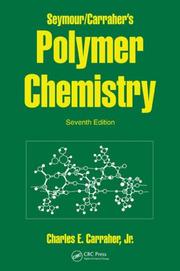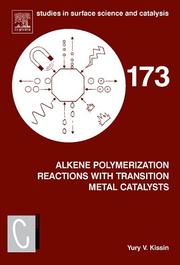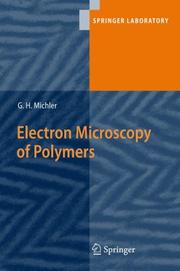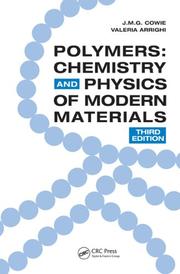| Listing 1 - 10 of 54 | << page >> |
Sort by
|

ISBN: 1420051024 9781420051025 Year: 2008 Publisher: Boca Raton, Fla CRC Press
Abstract | Keywords | Export | Availability | Bookmark
 Loading...
Loading...Choose an application
- Reference Manager
- EndNote
- RefWorks (Direct export to RefWorks)
fysicochemie --- Macromolecules --- Polymerization --- Polymers
Book
Year: 2008 Publisher: Aberdeen Proving Ground, MD : Army Research Laboratory,
Abstract | Keywords | Export | Availability | Bookmark
 Loading...
Loading...Choose an application
- Reference Manager
- EndNote
- RefWorks (Direct export to RefWorks)
Polymers. --- Polymerization. --- Armor.
Book
Year: 2008 Publisher: Aberdeen Proving Ground, MD : Army Research Laboratory,
Abstract | Keywords | Export | Availability | Bookmark
 Loading...
Loading...Choose an application
- Reference Manager
- EndNote
- RefWorks (Direct export to RefWorks)
Polymers. --- Polymerization. --- Armor.
Book
ISBN: 1281775460 1847351247 9786611775469 1601196687 9781847351241 1847351220 9781847351227 1847351239 9781847351234 9781847351265 1847351263 9781847351258 1847351255 9781847351326 9781847351289 9781847351234 9781847351227 9781281775467 6611775463 9781601196682 9786612085949 6612085940 1847351271 9781847351272 1282085948 9781282085947 Year: 2008 Publisher: Shawbury, UK : Smithers Rapra,
Abstract | Keywords | Export | Availability | Bookmark
 Loading...
Loading...Choose an application
- Reference Manager
- EndNote
- RefWorks (Direct export to RefWorks)
This essential guide to Polymer Characterization is a complete compendium of methodologies that have evolved for the determination of the chemical composition of polymers. This 478-page book gives an up-to-date and thorough exposition of the state-of-the-art theories and availability of instrumentation needed to effect chemical and physical analysis of polymers. This is supported by approximately 1200 references. Volume 1 covers the methodology used for the determination of metals, non-metals and organic functional groups in polymers, and for the determination of the ratio in which different
Polymers --- Polymere --- Polymeride --- Polymers and polymerization --- Macromolecules --- Analysis. --- Research --- Methodology.
Book
ISBN: 9786612085949 1847351271 1282085948 9781847351272 Year: 2008 Publisher: Shawbury, UK : Smithers Rapra,
Abstract | Keywords | Export | Availability | Bookmark
 Loading...
Loading...Choose an application
- Reference Manager
- EndNote
- RefWorks (Direct export to RefWorks)
This book is intended to be a complete compendium of the types of methodology that have evolved for the determination of the chemical composition of polymers.Volume 1 covers the methodology used for the determination of metals, non-metals and organic functional groups in polymers, and for the determination of the ratio in which different monomer units occur in copolymers. The techniques available for composition determination of homopolymers and copolymers and other recent modern techniques such as X-ray photoelectron spectroscopy, atomic force microscopy, microthermal analysis and scanning el
Polymers --- Polymere --- Polymeride --- Polymers and polymerization --- Macromolecules --- Analysis. --- Research --- Methodology.

ISBN: 1281165093 9786611165093 0080557996 1435628756 0444532153 9780444532152 9781435628755 9780080557991 Year: 2008 Publisher: Amsterdam London Elsevier
Abstract | Keywords | Export | Availability | Bookmark
 Loading...
Loading...Choose an application
- Reference Manager
- EndNote
- RefWorks (Direct export to RefWorks)
During the past 30 years, the field of alkene polymerization over transition metal catalysts underwent several major changes:1. The list of commercial heterogeneous Ziegler-Natta catalysts for the synthesis of polyethylene and stereoregular polyolefins was completely renewed affording an unprecedented degree of control over the polymer structure.2. Research devoted to metallocene and other soluble transition-metal catalysis has vastly expanded and has shifted toward complexes of transition metals with multidentate ligands.3. Recent developments in gel permeation chromatography,
Polymerization. --- Transition metal catalysts. --- Metal catalysts --- Polymerisation --- Polymers --- Polymers and polymerization --- Synthesis of polymers --- Chemical reactions --- Synthesis

ISBN: 9783540363507 9783540363521 Year: 2008 Publisher: Berlin Springer
Abstract | Keywords | Export | Availability | Bookmark
 Loading...
Loading...Choose an application
- Reference Manager
- EndNote
- RefWorks (Direct export to RefWorks)
There are many books on electron microscopy, however, the study of polymers using EM necessitates special techniques, precautions and preparation methods, including ultramicrotomy. This book discusses the general characteristics of the various techniques of EM, including scanning force microscopy (AFM). The application of these techniques to the study of morphology and properties, particularly micromechanical properties, is described in detail. Examples from all classes of polymers are presented.
Electron microscopy --- Polymers --- Polymere --- Polymeride --- Polymers and polymerization --- Macromolecules --- Microscopy --- Optical properties
Dissertation
ISBN: 9783832520748 3832520740 Year: 2008 Volume: Bd. 4 Publisher: Berlin Logos
Abstract | Keywords | Export | Availability | Bookmark
 Loading...
Loading...Choose an application
- Reference Manager
- EndNote
- RefWorks (Direct export to RefWorks)
Plasma polymerization --- Plasma chemistry --- Polymérisation sous plasma --- Plasmachimie --- Industrial applications --- Applications industrielles

ISBN: 9780849398131 0849398134 9781420009873 Year: 2008 Publisher: Boca Raton : CRC Press,
Abstract | Keywords | Export | Availability | Bookmark
 Loading...
Loading...Choose an application
- Reference Manager
- EndNote
- RefWorks (Direct export to RefWorks)
62-039.5 --- Polymer matrix composites --- 62-039.5 Polymer matrix composites --- Polymerization --- Polymers --- Polymere --- Polymeride --- Polymers and polymerization --- Macromolecules --- Polymerisation --- Synthesis of polymers --- Chemical reactions --- Synthesis --- fysicochemie --- Solid state physics
Multi

ISBN: 9789086491605 Year: 2008 Publisher: Leuven K.U.Leuven. Faculteit Wetenschappen
Abstract | Keywords | Export | Availability | Bookmark
 Loading...
Loading...Choose an application
- Reference Manager
- EndNote
- RefWorks (Direct export to RefWorks)
Dendrimeren zijn reeds langer bekend dankzij hun unieke moleculaire architectuur en de hiermee verbonden eigenschappen en mogelijke toepassingen. Hypervertakte polymeren werpen zich op als goedkopere vervangers van dendrimeren daar hun synthese mogelijk is in slechts één stap in tegenstelling tot de opeenvolgende stappen en zuiveringen die een dendrimeersynthese vereist. Hypervertakte polymeren bezitten echter niet de perfecte structuur van dendrimeren. Dit kan mogelijkerwijs bepaalde interessante eigenschappen nadelig beïnvloeden, maar een manier om dit te voorkomen bestaat erin gebruik te maken van bouwstenen die reeds (een aanzet tot) de nagestreefde eigenschappen (eventueel in beperkte mate) vertonen. De eigenschappen waar we ons op gericht hebben zijn een bepaalde ruimtelijke opbouw met ruimte voor complexatie of inclusie van kleine moleculen tot gevolg en een ingebouwde ‘aanleg’ tot vertakking. Als monomeereenheid opteerden we daarom voor de pyrrolo-antracenen. Van dit type van moleculen zijn al langer de goede complexerende of inclusie-eigenschappen bekend. Er werd gekozen voor atoomtransfer radicalaire polymerisatie (ATRP), hier in de gedaante van de zogenaamde zelfcondenserende vinylpolymerisatie, omdat dit type van polymerisatie gedurende langere tijd gecontroleerd kan verlopen, niet erg gevoelig is voor onzuiverheden en polymeren met een nauwe polydispersiteit oplevert. Indien we een symmetrische bouw aanhouden, leidt dit tot A(B*)2-type monomeren, met een polymeriseerbare groep A en initiërende functies in een slapende vorm B*. Per ingebouwde monomeereenheid ontstaan er twee nieuwe vertakkingspunten. Dit type van monomeren of hypervertakte polymeren werd tot op heden niet beschreven in de literatuur, waardoor er de nood was om modelpolymeren te synthetiseren. Een polymeer met als gemiddelde molecuulmassa 5600 dalton en een nauwe polydispersiteit van 1.20 werd gevormd. Voordat getracht werd een pyrroloantraceen van het A(B*)2-type te polymeriseren werd eerst getest of dit type van moleculen compatibel is met ATRP en dus met de aanwezigheid van, zij het vrij lage concentraties van, radicalen. Een pyroloantraceentype initiator werd gesynthetiseerd en hiermee werd succesvol de atoomtransfer radicalaire polymerisatie van styreen geïnitieerd. Voorts werd ook getest of het mogelijk was om pyrroloantracenen te copolymeriseren of in te bouwen in een polystyreenketen. Dit bleek mogelijk en met 1H-NMR spectroscopie, GPC en massaspectrometrie werd bewezen dat het comonomeer met succes was geïncorporeerd in het polystyreen gevormd via ATRP. We zijn er echter niet in geslaagd om een A(B*)2-type monomeer te synthetiseren. Alle pogingen strandden uiteindelijk door de te hoge reactiviteit van de benzylische posities in para-stelling ten opzichte van de pyrroolkern. Werken met een spacer op deze posities zou dit probleem kunnen omzeilen, maar dit werd niet verder getest wegens tijdsgebrek. Dendrimers are known for their unique molecular architecture, the corresponding characteristics and thus possible applications. Hyperbranched polymers present themselves as inexpensive substitutes for dendrimers, since their synthesis is possible in a single reaction step, in contrast to the sequential reactions and purifications required for the synthesis of dendrimers. Hyperbranched polymers however, do not possess the perfect structure of the latter. This could possibly affect some of the interesting characteristics, but this might be avoided by careful selection of the building blocks. The targeted properties in this work are the ability of complexation or inclusion of small molecules and a intrinsically branched geometry. Therefore, we chose pyrroloanthracenes as the monomeric unit since their strong complexing and/or inclusion properties have been known for years. The choice was also made to use the atom transfer radical polymerization (ATRP), here as the so called self-condensing vinyl polymerization. This kind of polymerization propagates in a controlled way for longer times, is not very sensitive to impurities and yields polymers with a narrow polydispersity. Following a symmetric synthetic pathway gives rise to an A(B*)2-type of monomer with a polymerisable group A and two initiating functions in a dormant state B*. For each incorporated monomeric unit, two new branching points are added to the macromolecule. This type of monomers or hyperbranched polymers has not been described in the literature yet, which made it necessary to synthesize model polymers. Before the polymerization of an A(B*)2-type pyrroloanthracene could be tried, a test had to be performed to check if this type of molecule is compatible with ATRP and thus the presence of radicals in low concentrations. An initiator molecule containing a pyrroloanthracene was synthesized and successfully applied to initiate an atom transfer radical polymerization of styrene. Another test was performed to copolymerise and incorporate a pyrroloanthracene-based vinyl monomer in a polystyrene chain via ATRP. The success of these reactions was proven by 1H-NMR spectroscopy, GPC and mass spectrometry. We, however, did not succeed in synthesizing an A(B*)2-type monomer based on the pyrroloanthracene skeleton. The final attempts failed due to the extreme reactivity of the benzylic positions in the para position with respect to the pyrrole core.
Academic collection --- 66.095.26 <043> --- 547.672 <043> --- 547.672 <043> Anthracene and its derivatives. Anthrahydroquinone. Chrysarobin--Dissertaties --- Anthracene and its derivatives. Anthrahydroquinone. Chrysarobin--Dissertaties --- 66.095.26 <043> Polymerization--Dissertaties --- Polymerization--Dissertaties --- Theses --- Macromolecules --- fysicochemie
| Listing 1 - 10 of 54 | << page >> |
Sort by
|

 Search
Search Feedback
Feedback About
About Help
Help News
News